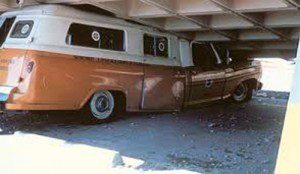
The only time I came close to experiencing a natural disaster first-hand was in 1971. I landed in Los Angeles a few weeks after the 6.6 magnitude Sylmar earthquake rattled the San Fernando Valley. At the time, my parents and sister lived in the valley suburb known as Tarzana (where MGM studios shot all those movies with Johnny Weissmuller as Tarzan back in the 1930s). I remember sitting in my folks’ living room a few nights after I’d arrived when I felt a faint vibration beneath me. I looked at my sister.
“Oh, that’s nothing,” she said casually. “Just an after shock.”
I wonder whether Rev. Harold Camping predicted that one. He’s the California preacher who inaccurately predicted that the world would end last Saturday at 6 p.m. Camping is already calling last weekend’s non-event “an invisible judgment day.”
What angers me most about this latter day Nostradamus is why he wasted our time with inaccurate prognostications? Where was Camping last Tuesday when the residents of Slave Lake, Alberta, had to run for their lives from marauding wildfires? Or what about a heads-up for the residents along the flooded Assiniboine and Richelieu rivers? And how come he didn’t forewarn the unsuspecting citizens of Joplin, Missouri, that a tornado would descend and kill 117 of them?
Inappropriate Judgment Day predictions aside, all the natural disaster locations of the past couple of weeks have resonated with me for different reasons. The most recent, Joplin, I remember from my college days. In the spring of 1968, one of my best pals and I decided to do our very own version of the hit TV show “Route 66,” driving from Canada to L.A. via the famous trans-American highway.
Of course, he was Marty Milner (Tod Stiles) and I was the Greek sensation George Maharis (Buz Murdock). And we just imagined that my mom’s reliable old 1965 Valiant was Stiles’s and Maharis’s spiffy red Corvette.
Anyway, about the second or third day down Route 66, we got to Joplin. I remember witnessing for the first time the city’s huge century homes, wide prairie streets and famous House of Lords saloon – with a bar on the first floor, gambling on the second and brothels on the third (at least, that’s what we’d heard). Following this week’s tornado, however, what stuck in my head more than my Joplin mythology was that it was now home to 50,000 terrified residents.
I first visited the town of Slave Lake in June 1974. My wife and I were on a four-month research trip, gathering stories about the first primary means of transportation across the West – prairie steamboats. On our first night in Slave Lake, we were directed to the farm of an elderly couple – Lizzie Hall and Rennie Hall. We’d been told that in 1912 the brother and sister (teenagers then) had been shipped by their mother to western Canada in search of their father Joseph Hall, who’d come out from England in 1909 to find a homestead for the family. En route to their father’s new 160 acres of land, Lizzie and Rennie had travelled aboard a lake steamboat.
The June night in 1974 that they regaled us with stories of their travels 60 years before, we sat in the nearly completed kitchen of their brand new bungalow (Lizzie and Rennie had reluctantly moved into the bungalow from an old homestead house built originally of sod and wood). Though the bungalow was equipped with modern conveniences (including electric lights), out of habit Lizzie and Rennie had lit a kerosene lamp, which emitted a ribbon of black smoke across the kitchen all evening long.
All that came back to me as I heard about the fire that had burned down 30 per cent of Slave Lake in a few hours last week and of the instant destruction it had inflicted. No doubt Lizzie and Rennie were long gone.
That same year – 1974 – interviews and research had taken us to Brandon, Manitoba, through which the Assiniboine River flows. I remember commenting then about how low the river seemed to be and consequently how difficult it must have been for paddlewheel steamboats to navigate past rapids and across sandbars in their heyday in the 1880s and ’90s. Of course, with modern flooding and last week’s controlled dike breach along the Assiniboine, I thought about farmers filling sandbags not buckets, praying for sunshine not rain and a prairie waterway all these years later still governing the lives of its riverside residents.
The natural disasters of the past few weeks have remained at arm’s length, but close enough for me to realize their human cost. My hope is that family, friends and governments offer more support than the phony doomsday predictors who get more ink and airtime than the real victims of natural disasters.